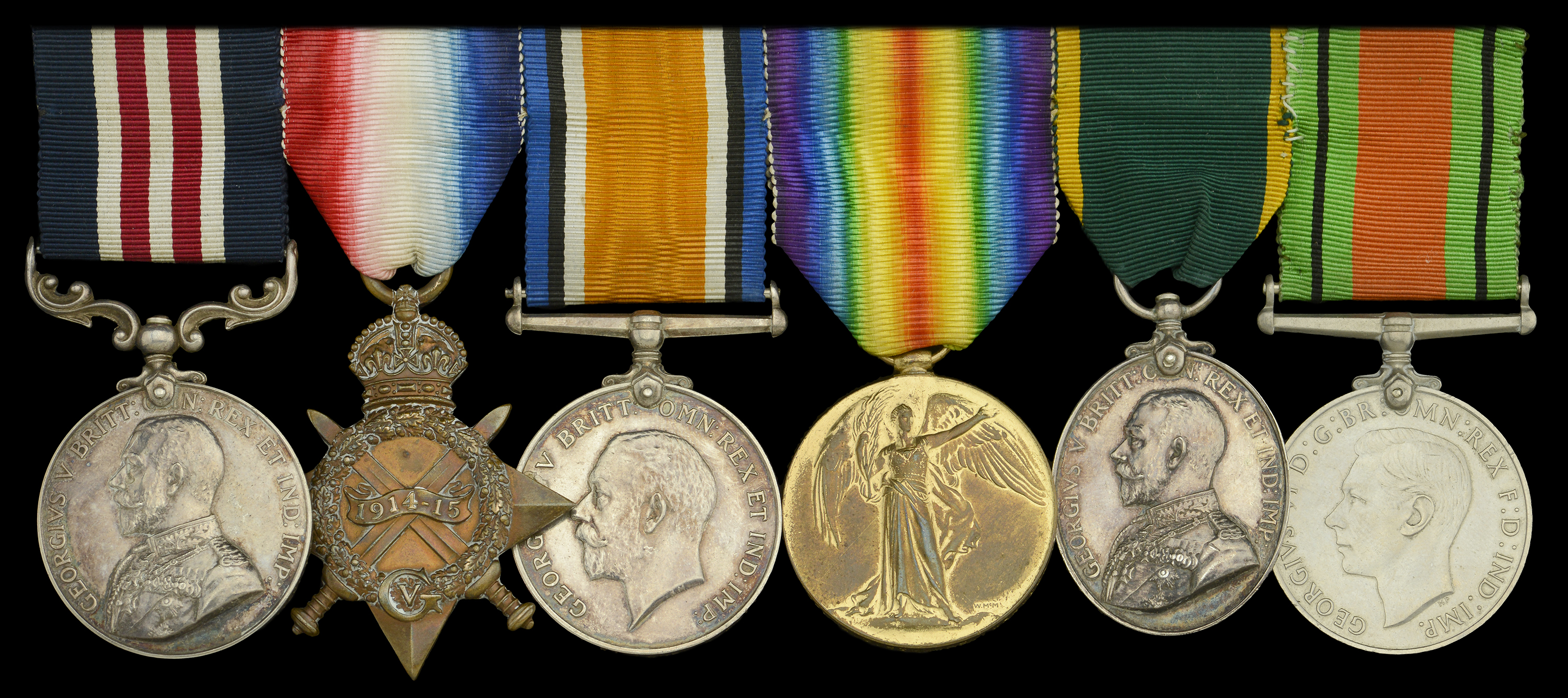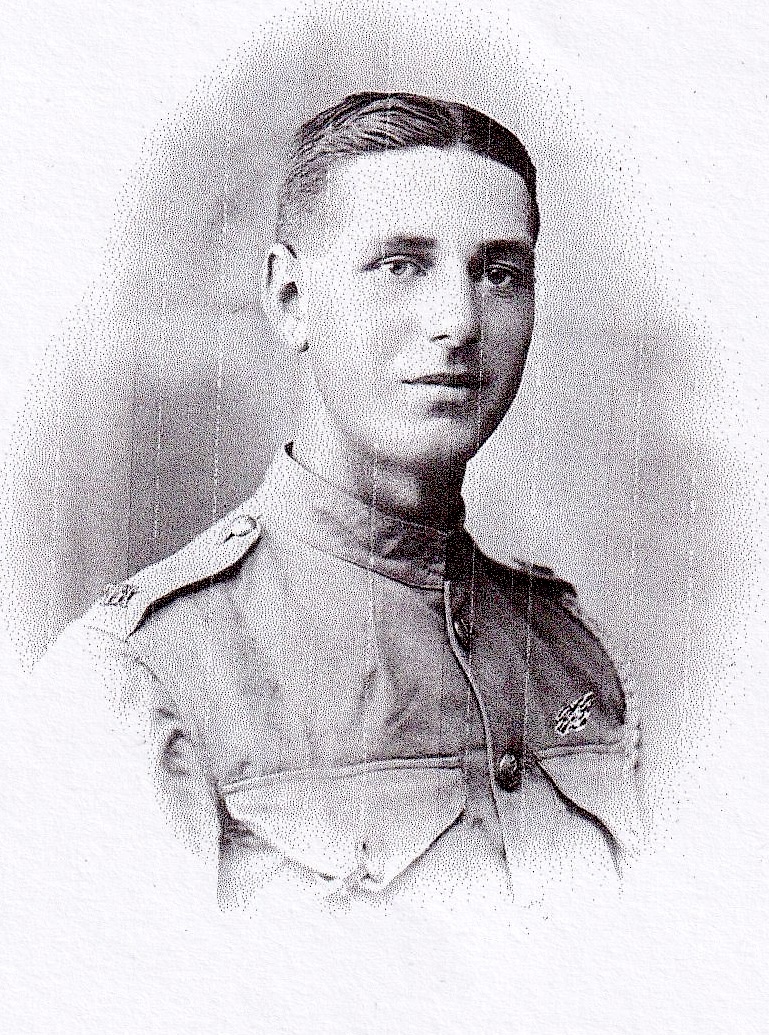41
A Great War 'Palestine operations' M.M. group of six awarded to Corporal H. V. Simmons,...
Gebote sind ohne Steuern, Aufgeld oder Versankosten.
By confirming your bid, you agree that you have read and accepted the-saleroom.com and the auctioneer's terms and conditions. Confirming your bid is a legally binding obligation to purchase and pay for the lot should your bid be successful.
Wählen Sie eine der folgenden Schnellgebotsoptionen:
Gebote sind ohne Steuern, Aufgeld oder Versankosten.
By confirming your bid, you agree that you have read and accepted the-saleroom.com and the auctioneer's terms and conditions. Confirming your bid is a legally binding obligation to purchase and pay for the lot should your bid be successful.
Military Medal, G.V.R. (310294 L. Cpl. H. V. Simmons. War: Yeo: -T.F.); 1914-15 Star (1799 Pte. H. V. Simmons. Warwick. Yeo.); British War and Victory Medals (1799 Cpl. H. V. Simmons. Warwick. Yeo.); Territorial Force Efficiency Medal, G.V.R. (1799 Pte. -A. Cpl.- H. V. Simmons. War. Yeo.); Defence Medal, mounted as worn in this order, traces of adhesive to reverse of Star, good very fine and better (6) £3,000-£4,000
---
M.M. London Gazette 10 April 1918.
Henry Victor Simmons was born at King’s Norton, Worcestershire, on 2 July 1893 and attested for the Warwickshire Yeomanry (Territorial Force), serving with them during the Great War in the Egyptian theatre of War from 24 April 1915. Sometime attached to the Machine Gun Corps, he distinguished himself in the brilliant charge carried out by the Warwickshire Yeomanry and Worcestershire Yeomanry at Huj, Palestine, on 8 November 1917, during which he was wounded. Recommended for his gallantry during the charge by Lieutenant-Colonel Gray-Cheape, he was ultimately awarded the Military Medal.
The Charge at Huj
‘The Worcesters led the way: Major M. C. Albright's 'A' Squadron of the Worcesters, followed by two troops of 'C' Squadron under Second-Lieutenant J. W. Edwards. Bringing up the rear was Captain R. Valintine's 'B' Squadron of the Warwicks, followed by two troops of 'C' Squadron.
As they advanced at a brisk trot from the south-west end of the ridge they could not see the hostile guns firing at the infantry of the 60th about 11,350 yards away. They then moved north-eastwards under (as they thought) the ridge's protection, in line of troop columns. When they were some 300 yards from the northern tip of the ridge, these hitherto unseen guns - a 75mm Austrian battery - came into sight about 1,000 yards almost due west. Between them and the cavalry it was noticed that the ground, though undulating, was perfectly open.
As the yeomen trotted on they raised clouds of dust. This alerted the Austrian gunners who swung round two of their guns and fired at the horsemen as they came on. Little harm was done for by now the yeomen were gathering speed and it was difficult for the gunners to pick up the range quickly enough. The squadrons halted for a brief moment near to the northern tip of the ridge, but they were instantly subjected to heavy fire from four mountain battery guns and some 200 riflemen, numbers of whom stood up to take aim. These were positioned on a slight ridge to the north-west, some 600 yards distant.
Albright, realizing that the attack on the main target to the left could not go ahead while these guns and infantrymen were in a position to enfilade it, formed his men in column of half squadrons and 'went,' according to Wiggin, 'straight on to attack this lot immediately he realized the position and without waiting for further orders either from me or from Lieutenant-Colonel Cheape.’ To avoid the shock, some of the Turkish infantry fired wildly, others wavered, but the majority 'fled down the reverse slope with the victorious horsemen thundering at their heels.’ Although many more Turks could have been put to the sword (considerable numbers were) and although the guns of a retreating 5.9 howitzer battery which they were protecting, as well as the mountain guns, were at 'A' Squadron's mercy, Wiggin instantly ordered Albright to break off the pursuit. This wise decision was occasioned by what he saw of the troubled position which Valintine's Warwicks and Edwards's Worcesters were in.
A few moments after Albright had launched his charge, Cheape had ordered Valintine, with Edwards's two troops slightly echeloned to the right, to lead them over the crest of the northern end of the boomerang ridge and to charge the Austrian 75mm guns in flank. Valintine, like Albright before him, formed his men into column of half-squadrons with swords at the 'engage' and the moment they cleared the crest the Austrian gunners opened fire on them with 'an absolute inferno of shells.' Four machine guns behind them and about two companies of riflemen, all protecting the 75mm guns, also opened a fierce fire upon the galloping, shouting yeomen. The distance they had to cover was some 900 yards down a slope and up the other side, 'with the last 100-150 yards very steep indeed'. The Austrians depressed their muzzles to the maximum and set their fuses at zero so that the shells exploded almost as soon as they left the barrels. It was only a matter of moments before Albright, having rallied and reformed his men, joined in the charge in echelon from the right, sweeping down on the gunners' left flank. The Austrians stuck most heroically to their guns. Their final shot, indeed, 'passed through a horse that was almost at the gun's muzzle'. 'Few,' according to Lieutenant Alan-Williams, 'remained standing and, where they did, they were instantly sabred. Others, running away from the guns, threw themselves on the ground on being overtaken and thus saved themselves, for it was found almost impossible to sabre a man lying down at the pace we were travelling.'
Despite terribly high casualties, the yeomen, equally heroically, broke right through the battery, riding down the gunners, sabreing numbers of them, and then hurled themselves, by now perhaps only twenty in number, against the machine guns. These were taken a few seconds later by Albright's Worcesters as they swung to the right. Most of the Turkish foot soldiers, possibly 200 in number, when they saw this second charge bearing down on them, quickly broke and fled, a few stopping to take pot shots at the yeomen who managed to cut down quite a number. They probably thought that the troops opposed to them were far more numerous than they were. The fact that they were not ruled out any question of a pursuit, but at this moment the machine-gun sub-section which had followed the squadrons arrived on the scene and turned its two guns, as well as the four captured ones, on the fleeing Turkish riflemen, mowing down many of them. Some seventy were made prisoner.
While this formidable charge, lasting, from start to finish, according to one authority, about twenty minutes, was in progress, Cheape had led his two remaining troops of the Warwicks off to the right, where he intercepted the 5.9 howitzer battery. This he captured complete, as well as the abandoned camel-pack mountain-gun battery. At this moment Lieutenant-Colonel Williams returned from his mission to bring up the 4th Australian Brigade which failed to reach the scene of action in time to take up the pursuit. He found a horrible scene of carnage and in its midst the three remaining officers of his regiment arranging the defence of the captured ridge with the few unwounded men who remained. He was helped by the Warwicks' Second-in-Command who brought to the task the few men of his regiment who had been unhorsed or outpaced in the charge. The position was consolidated and the 60th Division, meeting little further opposition, was at once able to establish itself three miles north-west of Huj.
“Suddenly,” noted the Worcesters' Medical Officer as he rode up to the battlefield, “the terrific din of shrieking and exploding shells ceased and we knew the end had come. A wonderful and terrible sight met our view.... The ground was strewn with horses and fallen yeomen, many of whom were lying close to, and some beyond, the batteries.... [The guns] were in various positions surrounded by Austrian and German gunners, many of whom were dead or wounded.... Our squadrons had not fired a shot...
Military Medal, G.V.R. (310294 L. Cpl. H. V. Simmons. War: Yeo: -T.F.); 1914-15 Star (1799 Pte. H. V. Simmons. Warwick. Yeo.); British War and Victory Medals (1799 Cpl. H. V. Simmons. Warwick. Yeo.); Territorial Force Efficiency Medal, G.V.R. (1799 Pte. -A. Cpl.- H. V. Simmons. War. Yeo.); Defence Medal, mounted as worn in this order, traces of adhesive to reverse of Star, good very fine and better (6) £3,000-£4,000
---
M.M. London Gazette 10 April 1918.
Henry Victor Simmons was born at King’s Norton, Worcestershire, on 2 July 1893 and attested for the Warwickshire Yeomanry (Territorial Force), serving with them during the Great War in the Egyptian theatre of War from 24 April 1915. Sometime attached to the Machine Gun Corps, he distinguished himself in the brilliant charge carried out by the Warwickshire Yeomanry and Worcestershire Yeomanry at Huj, Palestine, on 8 November 1917, during which he was wounded. Recommended for his gallantry during the charge by Lieutenant-Colonel Gray-Cheape, he was ultimately awarded the Military Medal.
The Charge at Huj
‘The Worcesters led the way: Major M. C. Albright's 'A' Squadron of the Worcesters, followed by two troops of 'C' Squadron under Second-Lieutenant J. W. Edwards. Bringing up the rear was Captain R. Valintine's 'B' Squadron of the Warwicks, followed by two troops of 'C' Squadron.
As they advanced at a brisk trot from the south-west end of the ridge they could not see the hostile guns firing at the infantry of the 60th about 11,350 yards away. They then moved north-eastwards under (as they thought) the ridge's protection, in line of troop columns. When they were some 300 yards from the northern tip of the ridge, these hitherto unseen guns - a 75mm Austrian battery - came into sight about 1,000 yards almost due west. Between them and the cavalry it was noticed that the ground, though undulating, was perfectly open.
As the yeomen trotted on they raised clouds of dust. This alerted the Austrian gunners who swung round two of their guns and fired at the horsemen as they came on. Little harm was done for by now the yeomen were gathering speed and it was difficult for the gunners to pick up the range quickly enough. The squadrons halted for a brief moment near to the northern tip of the ridge, but they were instantly subjected to heavy fire from four mountain battery guns and some 200 riflemen, numbers of whom stood up to take aim. These were positioned on a slight ridge to the north-west, some 600 yards distant.
Albright, realizing that the attack on the main target to the left could not go ahead while these guns and infantrymen were in a position to enfilade it, formed his men in column of half squadrons and 'went,' according to Wiggin, 'straight on to attack this lot immediately he realized the position and without waiting for further orders either from me or from Lieutenant-Colonel Cheape.’ To avoid the shock, some of the Turkish infantry fired wildly, others wavered, but the majority 'fled down the reverse slope with the victorious horsemen thundering at their heels.’ Although many more Turks could have been put to the sword (considerable numbers were) and although the guns of a retreating 5.9 howitzer battery which they were protecting, as well as the mountain guns, were at 'A' Squadron's mercy, Wiggin instantly ordered Albright to break off the pursuit. This wise decision was occasioned by what he saw of the troubled position which Valintine's Warwicks and Edwards's Worcesters were in.
A few moments after Albright had launched his charge, Cheape had ordered Valintine, with Edwards's two troops slightly echeloned to the right, to lead them over the crest of the northern end of the boomerang ridge and to charge the Austrian 75mm guns in flank. Valintine, like Albright before him, formed his men into column of half-squadrons with swords at the 'engage' and the moment they cleared the crest the Austrian gunners opened fire on them with 'an absolute inferno of shells.' Four machine guns behind them and about two companies of riflemen, all protecting the 75mm guns, also opened a fierce fire upon the galloping, shouting yeomen. The distance they had to cover was some 900 yards down a slope and up the other side, 'with the last 100-150 yards very steep indeed'. The Austrians depressed their muzzles to the maximum and set their fuses at zero so that the shells exploded almost as soon as they left the barrels. It was only a matter of moments before Albright, having rallied and reformed his men, joined in the charge in echelon from the right, sweeping down on the gunners' left flank. The Austrians stuck most heroically to their guns. Their final shot, indeed, 'passed through a horse that was almost at the gun's muzzle'. 'Few,' according to Lieutenant Alan-Williams, 'remained standing and, where they did, they were instantly sabred. Others, running away from the guns, threw themselves on the ground on being overtaken and thus saved themselves, for it was found almost impossible to sabre a man lying down at the pace we were travelling.'
Despite terribly high casualties, the yeomen, equally heroically, broke right through the battery, riding down the gunners, sabreing numbers of them, and then hurled themselves, by now perhaps only twenty in number, against the machine guns. These were taken a few seconds later by Albright's Worcesters as they swung to the right. Most of the Turkish foot soldiers, possibly 200 in number, when they saw this second charge bearing down on them, quickly broke and fled, a few stopping to take pot shots at the yeomen who managed to cut down quite a number. They probably thought that the troops opposed to them were far more numerous than they were. The fact that they were not ruled out any question of a pursuit, but at this moment the machine-gun sub-section which had followed the squadrons arrived on the scene and turned its two guns, as well as the four captured ones, on the fleeing Turkish riflemen, mowing down many of them. Some seventy were made prisoner.
While this formidable charge, lasting, from start to finish, according to one authority, about twenty minutes, was in progress, Cheape had led his two remaining troops of the Warwicks off to the right, where he intercepted the 5.9 howitzer battery. This he captured complete, as well as the abandoned camel-pack mountain-gun battery. At this moment Lieutenant-Colonel Williams returned from his mission to bring up the 4th Australian Brigade which failed to reach the scene of action in time to take up the pursuit. He found a horrible scene of carnage and in its midst the three remaining officers of his regiment arranging the defence of the captured ridge with the few unwounded men who remained. He was helped by the Warwicks' Second-in-Command who brought to the task the few men of his regiment who had been unhorsed or outpaced in the charge. The position was consolidated and the 60th Division, meeting little further opposition, was at once able to establish itself three miles north-west of Huj.
“Suddenly,” noted the Worcesters' Medical Officer as he rode up to the battlefield, “the terrific din of shrieking and exploding shells ceased and we knew the end had come. A wonderful and terrible sight met our view.... The ground was strewn with horses and fallen yeomen, many of whom were lying close to, and some beyond, the batteries.... [The guns] were in various positions surrounded by Austrian and German gunners, many of whom were dead or wounded.... Our squadrons had not fired a shot...
Orders, Decorations, Medals and Militaria
Auktionsdatum
Ort der Versteigerung
Generelle Versandinformationen vom Auktionshaus verfügbar
If you are successful in purchasing lot/s being auctioned by us and opt for the item/s to be sent to you, we will use the following methods of shipment:
Within the UK
If you live within the UK, items will be despatched using Royal Mail Special Delivery. This service provides parcel tracking (via the Royal Mail website) and next weekday delivery (betwen 9am and 1pm). Items delivered within the UK are covered by our insurance company. Heavy and bulky lots will be sent by courier, in discussion with the client.
Outside of the UK
If the item/s being sent are worth under £1000 in total they are sent using Royal Mail’s Signed For International service. This ensures the item must be signed for when it is delivered.
If the item/s being sent are valued at over £1000 in total they will be sent using FedEx. This service allows next day delivery to customers in many parts of the US and parcels are fully trackable using the FedEx website.
Shipping Exceptions
Certain lots such as those containing glass or sharp implements, etc., may not be suitable for in-house shipping within or outside of the UK. Please contact Noonans with any queries.
Wichtige Informationen
Auctioneer's Buyers Premium: 24% (+VAT)
There is an additional charge of 4.95% (+VAT/sales tax)














